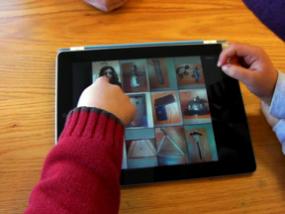Creating a Sound Alphabet on the iPad

This video clip begins with three children and two adults exploring MadPad™, an iPad app that allows children to create sound tracks to a set of twelve images arranged in a 3 by 4 matrix. The children can use the front video camera on the iPad to create a short video of themselves making sounds, or they can use the rear camera to take snap shots or video clips to go with sounds. When they touch any one of the twelve images, the respective audio loop plays once. The app also includes a large number of prefabricated images with sounds that the children can touch.
After an open-ended experience with MadPad the teacher (off camera) asks the children how this device could help them play music in the theater. Brian initially confirms that they could use funny sounds. Perhaps the children require more time with the MadPad before they can generalize the formal properties of this device in order to suggest new uses for it. The adults move the experience forward by responding to the children's wish to use the iPad to make their own sounds.
At 1:08 Brian has a funny sound ready to add to an image. At a minimum the MadPad app causes the children to explore the "funny" side of sounds. After Brian records a nasal whine, Sam, the technology teacher, taps the image so that Brian can hear that sound almost immediately. Then Sam touches the image rapidly, and the single sound becomes a phrase. The children laugh at the recognition of the repeated whine so similar to a baby's "Waaa waaa waaa." (01:29). Would they have laughed had the pitch changed with each "waa?." Probably not. Such are the syntactical rules children use to "read" sounds.
At 01:43 Sam invites Maia to choose a category of sounds in advance of making the sound (funny, serious or musical). When this seems too complicated for her, her teacher (off camera) offers Maia the option to tap the table. Maia does so in a slow rhythmical manner as Sam records and then plays back the rhythm. Maia listens but does not react. Now the children know how MadPad functions, so Sam suggests that they create an entire 12 image matrix of self-made sounds.
The children shift into a more reflective mode to consider what sounds to make that are not ordinary, that is, sounds that are worth recording. What is funny? What combinations of sounds can two children make? They also like to video their faces as they are making sounds and words that they deliberately distort or truncate. The device encourages them to play with phonetic variations that they would not otherwise consider.
Watch the last 20 seconds of this clip carefully. The iPad has become a keyboard of animated images with corresponding sounds. All three children play and build on each other's discoveries. If you look carefully you will see that they are testing paired sequences of two images; the first one followed by a similar sound or variation on the first. In summary, this device provides a method to create an alphabet of sounds, supported by relevant visual animation, in a keyboard matrix that can be used to compose interesting sequences - what we could call symbol literacy.
We will post more video clips on this application in the near future. If you have suggestions for its use in a school setting, please reply on our blog. For example, how could the MadPad be used to revisit the sounds recorded on a nature walk? How could it be used to create a set of facial expressions that show a range of emotions and meanings, not in still photographs, but in short video clips with representative sounds (laughs, groans, whoops, etc.)? After all, aren't emotions represented by how the face moves and not by some split second still shot? We welcome your suggestions.
